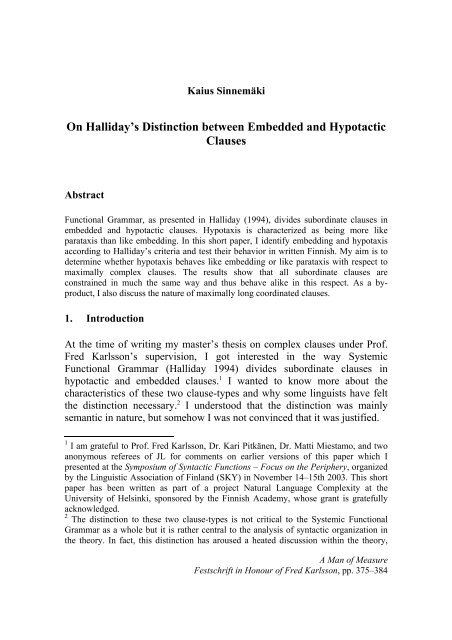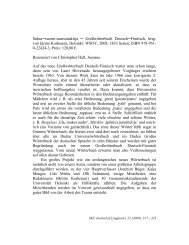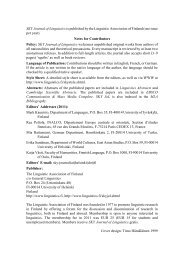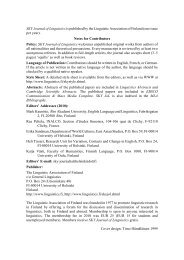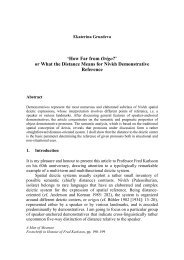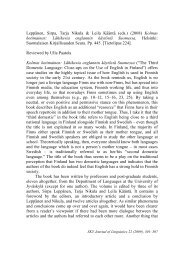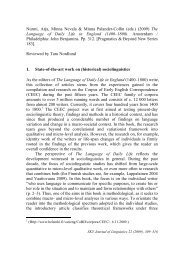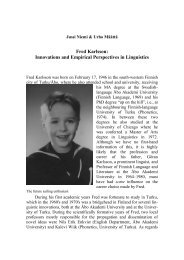On Halliday's Distinction between Embedded and Hypotactic Clauses
On Halliday's Distinction between Embedded and Hypotactic Clauses
On Halliday's Distinction between Embedded and Hypotactic Clauses
Create successful ePaper yourself
Turn your PDF publications into a flip-book with our unique Google optimized e-Paper software.
Kaius Sinnemäki<br />
<strong>On</strong> Halliday’s <strong>Distinction</strong> <strong>between</strong> <strong>Embedded</strong> <strong>and</strong> <strong>Hypotactic</strong><br />
<strong>Clauses</strong><br />
Abstract<br />
Functional Grammar, as presented in Halliday (1994), divides subordinate clauses in<br />
embedded <strong>and</strong> hypotactic clauses. Hypotaxis is characterized as being more like<br />
parataxis than like embedding. In this short paper, I identify embedding <strong>and</strong> hypotaxis<br />
according to Halliday’s criteria <strong>and</strong> test their behavior in written Finnish. My aim is to<br />
determine whether hypotaxis behaves like embedding or like parataxis with respect to<br />
maximally complex clauses. The results show that all subordinate clauses are<br />
constrained in much the same way <strong>and</strong> thus behave alike in this respect. As a byproduct,<br />
I also discuss the nature of maximally long coordinated clauses.<br />
1. Introduction<br />
At the time of writing my master’s thesis on complex clauses under Prof.<br />
Fred Karlsson’s supervision, I got interested in the way Systemic<br />
Functional Grammar (Halliday 1994) divides subordinate clauses in<br />
hypotactic <strong>and</strong> embedded clauses. 1 I wanted to know more about the<br />
characteristics of these two clause-types <strong>and</strong> why some linguists have felt<br />
the distinction necessary. 2 I understood that the distinction was mainly<br />
semantic in nature, but somehow I was not convinced that it was justified.<br />
1 I am grateful to Prof. Fred Karlsson, Dr. Kari Pitkänen, Dr. Matti Miestamo, <strong>and</strong> two<br />
anonymous referees of JL for comments on earlier versions of this paper which I<br />
presented at the Symposium of Syntactic Functions – Focus on the Periphery, organized<br />
by the Linguistic Association of Finl<strong>and</strong> (SKY) in November 14–15th 2003. This short<br />
paper has been written as part of a project Natural Language Complexity at the<br />
University of Helsinki, sponsored by the Finnish Academy, whose grant is gratefully<br />
acknowledged.<br />
2 The distinction to these two clause-types is not critical to the Systemic Functional<br />
Grammar as a whole but it is rather central to the analysis of syntactic organization in<br />
the theory. In fact, this distinction has aroused a heated discussion within the theory,<br />
A Man of Measure<br />
Festschrift in Honour of Fred Karlsson, pp. 375–384
376<br />
KAIUS SINNEMÄKI<br />
In a nutshell, hypotaxis is characterized as a relationship <strong>between</strong><br />
clauses, an interdependency relationship in which neither of the clauses is a<br />
constituent part of another, whereas embedding is a nominalizing device, a<br />
mechanism of rankshift in which a clause comes to function as a<br />
constituent part of another (Halliday 1987: 73, 1994: 242). For example,<br />
the subordinate clauses in the sentences I couldn’t come because I was sick<br />
<strong>and</strong> John thought that Alice wouldn’t come are in a hypotactic relation to<br />
the main clause; they are dependent on it but not constituents of it.<br />
<strong>Embedded</strong> clauses, on the other h<strong>and</strong>, have undergone a shift in rank from<br />
clause level to group level; they function as groups or parts of groups, 3 in<br />
the following functions only (Halliday 1994: 242):<br />
• head of a nominal group (e.g. It is obvious that Jeff wrecked the car)<br />
• post-modifier in a nominal group (I saw the car that Jeff wrecked)<br />
• post-modifier in an adverbial group (He came earlier than we had<br />
expected)<br />
In less theoretical parts of his scholarly writings, Halliday makes two<br />
rather strong claims about the characteristics of hypotaxis <strong>and</strong> embedding.<br />
Halliday (1987: 74) asserts that “[H]ypotaxis is more like parataxis than it<br />
is like embedding; <strong>and</strong> both are characteristic of spoken rather than written<br />
language” whereas Halliday (1985: 84) states that “[I]n mathematical<br />
terms, the hypotactic relation is one of iteration, whereas embedding is one<br />
of recursion.” These characterizations are not central to the distinction<br />
<strong>between</strong> the clause-types. However, they provide us with interesting<br />
viewpoints which are not found in Halliday (1994) but which are well<br />
worth commenting. In the following, I show that complex clauses in<br />
written Finnish provide evidence against Halliday’s claims. I admit my data<br />
is limited in scope, especially since it does not contain material from<br />
spoken language, but I believe the data shows clearly enough that<br />
hypotactic clauses are not as different from embedded clauses as Halliday<br />
claims.<br />
resulting in two opposing camps: “Sydney Grammar” holds on to the distinction<br />
whereas Cardiff Grammar rejects it altogether (e.g. Butler 1993: 259–292).<br />
3 In Systemic Functional Grammar group is a technical term for a clausal element which<br />
is similar but slightly different from that of phrase in Constituent Grammar.
ON HALLIDAY’S DISTINCTION BETWEEN<br />
EMBEDDED AND HYPOTACTIC CLAUSES<br />
2. Preliminary observations <strong>and</strong> the hypothesis<br />
Considering Halliday’s first claim, I think he possibly wanted to emphasize<br />
that hypotactic relationship does not involve rankshift of the clause. In that<br />
sense, hypotactic relation resembles paratactic relation <strong>between</strong> clauses.<br />
Earlier corpus-based studies also support his conclusion that written<br />
English is marked by complexity in the nominal group whereas spoken<br />
English is marked by complexity in the clause complex (e.g. Ellegård<br />
1978). However, I am amazed that Halliday’s examples from written <strong>and</strong><br />
spoken language are not always genuine instances but his own rewordings. 4<br />
Moreover, he occasionally bases his calculations of lexical density <strong>and</strong><br />
number of clauses, which are used to enhance the point that embedding<br />
characterizes written language <strong>and</strong> hypotaxis characterizes spoken<br />
language, partly on these fabricated examples. Therefore, the calculations<br />
do not convincingly reflect real differences in spoken <strong>and</strong> written modes<br />
but rather Halliday’s rewordings <strong>and</strong> intuitions about the differences<br />
<strong>between</strong> the two modes. There is a danger that his intuitions have been a<br />
priori influenced by too broad generalizations. In this article, I will not pay<br />
more attention to his claims on spoken vs. written language but will<br />
concentrate on the claim that hypotaxis is more like parataxis than<br />
embedding because it resembles his second claim.<br />
I’m not quite sure how I should underst<strong>and</strong> Halliday’s second<br />
statement, especially concerning the difference <strong>between</strong> recursion <strong>and</strong><br />
iteration. However, I assume that for Halliday iteration is potentially<br />
unlimited concatenation at the same rank level. Thus, a chain of clauses in<br />
which all clauses are either paratactic or hypotactic should be able to<br />
continue endlessly. However, he also sees recursion as unlimited (Halliday<br />
1987: 73), which is not helpful at all, making the allusion to iteration vs.<br />
recursion seem vacuous. The only difference <strong>between</strong> recursion <strong>and</strong><br />
iteration would be that clauses are concatenated at different rank level in<br />
recursion but at the same rank level in iteration. From a mathematical point<br />
of view both subordination <strong>and</strong> coordination are unlimited, but earlier<br />
corpus based studies (e.g. Karlsson 2004, Sinnemäki 2004) have shown<br />
that people hardly ever use sentences in which the descending level of<br />
subordination in a chain of subordinate clauses is more than –4 (when main<br />
4 This is illustrated by a quote from Halliday (1987: 61) “2B is my attempt at a<br />
somewhat less “written” version; while 2C is another step nearer to speech.”<br />
377
378<br />
KAIUS SINNEMÄKI<br />
clause is 0). As for coordinated clauses, it is easier to see that they might be<br />
concatenated unlimitedly.<br />
I assume that Halliday’s claims may be taken as predictions on text<br />
occurrences, although this might be a wrong assumption. Yet, I see no<br />
other way for evaluating the behavior of hypotactic clauses in actual<br />
language use. In order to do this, I combine parts of the two statements in<br />
my hypothesis which I will test with data from written Finnish: in<br />
maximally complex clauses, hypotactic clauses behave more like paratactic<br />
clauses <strong>and</strong> not like embedded clauses. What I mean by maximally<br />
complex is the possible upper limit of consecutively connected finite<br />
clauses, whether embedded, hypotactic or paratactic.<br />
3. Methods <strong>and</strong> data<br />
In order to test the hypothesis about the nature of hypotaxis, I specified two<br />
reference points as operational definitions: one for embedding <strong>and</strong> the other<br />
for parataxis. Firstly, I defined the reference point for parataxis as the chain<br />
of coordinated <strong>and</strong> juxtaposed main clauses (Halliday’s 1994 criteria for<br />
parataxis). I call this a paratactic chain. As an example, the length of the<br />
paratactic chain in the sentence Jack ate cake, Mary washed the dishes, but<br />
Mike slept in his bed is three (clauses). In order to find maximally long<br />
paratactic chains, I consulted a machine-readable corpus of the Finnish<br />
Language Bank. The sample corpus for this analysis consisted of roughly<br />
23 million words of machine-readable newspapers, magazines <strong>and</strong> prose in<br />
Finnish. I carried out this analysis by first marking the coordinating<br />
conjunctions automatically <strong>and</strong> then printing a list of instances with five or<br />
more conjunctions in journalistic writing <strong>and</strong> those with ten or more in<br />
prose. Finally, I analyzed these instances manually (roughly 35 pages) to<br />
detect both asyndetic <strong>and</strong> syndetic coordination. 5 Secondly, I defined the<br />
reference point for embedding as the chain of clauses that according to<br />
Halliday’s (1994) criteria were embedded. This is called an embedding<br />
chain. For example in (1) (from Suomen kuvalehti 1987), all subordinate<br />
clauses are embedded.<br />
Having set the reference points, I chose the sequence of hypotactic<br />
clauses (according to Halliday’s criteria), a hypotactic chain, as the variable<br />
5 The automatic analysis detected only syndetic coordination but the manual analysis<br />
included asyndetic coordination as well. The result was thus slightly suboptimal but<br />
does not affect the main conclusions.
ON HALLIDAY’S DISTINCTION BETWEEN<br />
EMBEDDED AND HYPOTACTIC CLAUSES<br />
whose values I compared to the reference-points. Sentence (2) (from<br />
L<strong>and</strong>er 1997) is an example of a hypotactic chain, in which all subordinate<br />
clauses are in a hypotactic relationship to the matrix clause. Finally, I also<br />
checked the maximal values of mixed chains which included both<br />
hypotactic <strong>and</strong> embedded clauses.<br />
(1) Sattui, M<br />
‘It happened’<br />
että minulle kertoi kokemuksistaan eräs<br />
työtovereistani,<br />
‘that to me told of his experiences one of my<br />
colleagues’<br />
joka äskettäin oli johtanut valtuuskuntaa Suomeen<br />
ja oli saanut sen kunnianosoituksen,<br />
‘who recently had lead a delegation to Finl<strong>and</strong> <strong>and</strong><br />
had received the mark of honor’<br />
että tasavallan presidentti otti valtuuskunnan<br />
vastaan.<br />
‘that the president of the republic received the<br />
delegation.’<br />
nominal group<br />
(fact)<br />
postmodifier of<br />
nominal group<br />
postmodifier of<br />
nominal group<br />
(2) Ymmärrän kyllä, M<br />
‘I well underst<strong>and</strong>’<br />
että filmi saattoi olla pelottava, Projection –1<br />
‘that the film might have been scary’<br />
jos ei tiedä, Enhancement/ –2<br />
‘if one doesn’t know’ adverbial<br />
mistä on kysymys. projection –3<br />
‘what it’s about’<br />
For the analysis of the embedding <strong>and</strong> hypotactic chains, I used a<br />
sample of two million words, a sub-corpus of the larger 23 million word<br />
sample. This analysis was a part of my master’s thesis (Sinnemäki 2004) in<br />
which I studied the constraints on right-branching clauses in Finnish.<br />
Firstly, I marked all the subordinating conjunctions <strong>and</strong> relative pronouns<br />
automatically. Secondly, I printed a list of those with three or more marks<br />
(roughly 120 pages) which I then manually analyzed in order to detect<br />
genuine instances of increasing chain length. As the two examples above<br />
illustrate, the longest chains of embedding <strong>and</strong> hypotaxis were typically<br />
right-branching clauses.<br />
379<br />
–1<br />
–2<br />
–3
380<br />
4. Results of the chain-analyses<br />
KAIUS SINNEMÄKI<br />
Since individual idiosyncrasies surface easier in prose than in journalistic<br />
writing, I have divided my results into these two genre categories in the<br />
corpus. Table 1 presents the results of the analyses.<br />
journalistic<br />
writing<br />
prose<br />
embedding chain 3 3<br />
hypotactic chain 4 5<br />
mixed chain 4 7<br />
paratactic chain 17 132<br />
Table 1. Maximal lengths of the chains<br />
The maximal length of the embedding chain was 3 clauses in both<br />
journalistic writing <strong>and</strong> prose. This was a rather clear upper limit, although<br />
there were only twelve instances of embedding chains that were 3 clauses<br />
long. 6 Paratactic chains, on the other h<strong>and</strong>, do not seem to obey any limit,<br />
since the lengths do not cluster around certain values. However, we must<br />
see behind the figures in more detail with the help of table 2.<br />
5–7 8–12 13–17 18–26 42–132<br />
magazines 7 0 1 0 0<br />
newspapers 5 0 1 0 0<br />
prose 12 9 4 8 3<br />
Table 2. Distribution of paratactic chains in the corpora<br />
The maximal length of the paratactic chain in newspapers was 17<br />
clauses. However, this instance was a long poem which is clearly a<br />
quotation from another genre. In addition, there were no paratactic chains<br />
whose length varied <strong>between</strong> 8 <strong>and</strong> 16 clauses. In magazines, the longest<br />
paratactic chain was 13 clauses, but there were no paratactic chains whose<br />
length varied <strong>between</strong> 8 <strong>and</strong> 12 clauses. Thus, although the maximal length<br />
6 The percentual share of embedding chains whose length is three clauses was 2.7% of<br />
all mixed chains whose length was three clauses. The corresponding share for<br />
hypotactic chains was 35.1%. This indicates that hypotactic clauses—or at least their<br />
sequences—are more frequent than embedded clauses not only in spoken language but<br />
also in written language.
ON HALLIDAY’S DISTINCTION BETWEEN<br />
EMBEDDED AND HYPOTACTIC CLAUSES<br />
of the paratactic chains were around 15 clauses in journalistic writing, there<br />
were only 2 paratactic chains longer than 7 clauses.<br />
In prose, there were eight paratactic chains whose lengths varied<br />
<strong>between</strong> 18 <strong>and</strong> 26 clauses <strong>and</strong> altogether 24 paratactic chains longer than 7<br />
clauses. In addition, I found one chain with 42, another with 102, <strong>and</strong> a<br />
third with 132 clauses, but all of them were by the same author. The<br />
longest chain was a sentence that formed a whole chapter in<br />
Tuulikaappimaa, a novel by Jari Tervo (1997), known for his tendency to<br />
employ stream-of-consciousness. If we focus solely on the longest<br />
paratactic chains, 17 clauses was the longest chain in journalistic writing<br />
whereas 132 clauses was the longest chain in prose. However, if we discard<br />
single oddities <strong>and</strong> instead focus on tendencies, the maximal length of the<br />
paratactic chain in journalistic writing tends to be around 7 clauses, while<br />
in prose it is somewhere around 25 clauses.<br />
We may now compare the length of the hypotactic chains to our two<br />
reference points. As the figures in table 1 show, the maximal length of the<br />
hypotactic chain was four clauses in journalistic writing <strong>and</strong> five clauses in<br />
prose. Thus, with hypotaxis the chains were one to two clauses longer than<br />
with embedding; the differences are very small. Even when the distinction<br />
was overlooked in the case of mixed chains, the length of the chain did not<br />
approach the maximal lengths of the paratactic chains. Moreover, all the<br />
longest hypotactic <strong>and</strong> mixed chains in prose occurred in Alastalon salissa, 7<br />
a novel by Volter Kilpi (1933), who employs techniques from stream-ofconsciousness<br />
style. If this novel were excluded from the sample, the<br />
maximal lengths of the hypotactic <strong>and</strong> mixed chains in prose would be<br />
identical with those of journalistic writing (four <strong>and</strong> four). All in all, the<br />
paratactic chains in journalistic writing were roughly two times longer, <strong>and</strong><br />
in prose roughly five times longer than hypotactic chains.<br />
5. Discussion<br />
My analysis of the sample data shows that there are good grounds for<br />
rejecting the original hypothesis—at least as far as it concerns written<br />
Finnish—namely: in maximally complex clauses hypotaxis does not<br />
behave like parataxis but more like embedding. Neither clause-type formed<br />
longer chains than 3–4 clauses whereas paratactic chains were unlimited. In<br />
7 The first 240 pages of this novel were analyzed for this paper.<br />
381
382<br />
KAIUS SINNEMÄKI<br />
relation to the feature of being constrained, all finite subordinate clauses in<br />
written Finnish seem to behave in a closely related way. 8 Of course it is<br />
possible that subordinate clauses in written language are affected by<br />
prescriptive norms of writing. However, the maximal lengths of mixed<br />
chains in spoken language in Ikola & al. (1989) were seven clauses, but<br />
they consider chains longer than four clauses possible coding errors of the<br />
analyst. Their results thus confirm my observations.<br />
No upper limit seems to exist for parataxis. What I mean by “upper<br />
limit” (or being unlimited) for paratactic chains is that their maximal values<br />
did not cluster around certain values as clearly as those for subordinate<br />
clauses. Nevertheless, I’m not sure whether “unlimited” should be<br />
interpreted here as “infinite”. It may be argued that such interpretations are<br />
h<strong>and</strong>y theoretical hyperboles for approximating natural language with<br />
artificial languages (Tero Kainlauri, p.c.). Of course speakers or writers<br />
may produce sentences with more than 132 clauses in a paratactic chain.<br />
Yet, infinitely long sentences exist as theoretical possibilities but their<br />
actual instantiations are impossible: infinite is different from much.<br />
It is also highly interesting to consider why maximally long paratactic<br />
chains tended to cluster around 7 clauses in journalistic writing <strong>and</strong> 25<br />
clauses in prose. For journalistic writing there are obvious limitations<br />
imposed by space <strong>and</strong> the norms of news discourse. In general, the longer<br />
the sentence the more it begins to resemble a paragraph. Oxford English<br />
Dictionary <strong>On</strong>line defines paragraph as a thematic entity that is set apart<br />
from what st<strong>and</strong> before or after it. Obviously, thematic entities are<br />
preferably built up of small distinct information chunks rather than one<br />
huge chunk. Cutting the information in smaller pieces enables the hearer to<br />
decode the thematic content more efficiently. I think this tendency is<br />
exploited in artistic writing, such as Tuulikaappimaa <strong>and</strong> Alastalon salissa.<br />
They bend the norms of st<strong>and</strong>ard writing by bending the extent of sentence<br />
towards that of st<strong>and</strong>ard paragraph in order to gain text strategic effects. 9<br />
This is especially obvious as we consider the fact that the longest mixed<br />
chains in Alastalon salissa are close to the longest paratactic chains in<br />
journalistic writing.<br />
8<br />
In his study on clausal embedding complexity, Karlsson (2004) shows that the<br />
inclusion of non-finite clauses typically adds only one clause to the maximally long<br />
chains of subordinate clauses.<br />
9<br />
The norms of typical writing are bent e.g. by employing deviate punctuation (see<br />
Sinnemäki 2004: 77).
ON HALLIDAY’S DISTINCTION BETWEEN<br />
EMBEDDED AND HYPOTACTIC CLAUSES<br />
As a conclusion, finite subordinate clauses do not form endlessly long<br />
chains in written Finnish. But as it seems, neither do coordinate clauses,<br />
although they are not constrained by as clear limit as subordinate clause<br />
are. My results raise a very interesting question for grammarians,<br />
psycholinguists <strong>and</strong> discourse analysts alike, namely: what are the factors<br />
underlying the greater difficulty of long mixed chains compared to long<br />
paratactic chains. I assume the answers lie in the grammatical<br />
(in)dependency of these clauses as well as in their information conveying<br />
functions in discourse. However, this remains an open question for future<br />
research.<br />
Data sources<br />
Finnish Language Bank. A sample of roughly 23 million words of Finnish electronic<br />
documents. Consisted of samples from seven newspapers (Keskisuomalainen,<br />
Helsingin Sanomat, Aamulehti, Demari, Kauppalehti, Iltalehti, Karjalainen),<br />
three magazines (Tekniikan maailma, Kauppalehti-Optio, Suomen Kuvalehti), <strong>and</strong><br />
82 novels <strong>and</strong> text books by various authors, published by WSOY, Otava,<br />
University of Helsinki, Finnish Literature Society, <strong>and</strong> Edita. Compiled by the<br />
Department of General Linguistics, University of Helsinki, Research Institute for<br />
the Languages of Finl<strong>and</strong> [KOTUS] <strong>and</strong> CSC – Center for Scientific Computing,<br />
Finl<strong>and</strong>. Available at URL: http://www.csc.fi/kielipankki/. Managed by the Center<br />
for Scientific Computing.<br />
Kilpi, Volter (1933) Alastalon salissa: kuvaus saaristosta. Helsinki: Otava.<br />
L<strong>and</strong>er, Leena (1997) Iloisen kotiinpaluun asuinsijat. Porvoo, Helsinki & Juva: Werner<br />
Söderström Osakeyhtiö.<br />
Oxford English Dictionary (2005) Oxford: Oxford University Press. Available at URL:<br />
http://dictionary.oed.com/entrance.dtl (4.11.2005).<br />
Suomen Kuvalehti (1987) A sample of roughly 0.5 million words of machine readable<br />
magazine articles in Finnish. Compiled by the Department of General Linguistics,<br />
University of Helsinki, Research Institute for the Languages of Finl<strong>and</strong> [KOTUS]<br />
<strong>and</strong> CSC – Center for Scientific Computing, Finl<strong>and</strong>. Available at URL:<br />
http://www.csc.fi/kielipankki/.<br />
Tervo, Jari (1997) Tuulikaappimaa. Porvoo, Helsinki & Juva: Werner Söderström<br />
Osakeyhtiö.<br />
383
384<br />
References<br />
KAIUS SINNEMÄKI<br />
Butler, Christopher S. (2003) Structure <strong>and</strong> Function: A Guide to Three Major<br />
Structural-Functional Theories. Part 2: From clause to discourse <strong>and</strong> beyond.<br />
Studies in Languages Companion Series 64. Amsterdam & Philadelphia, PA: John<br />
Benjamins.<br />
Ellegård, Alvar (1978) The Syntactic Structure of English Texts: A computer-based<br />
study of four kinds of text in the Brown University corpus. Gothenburg Studies in<br />
English 43. Gothenburg: Acta Universitatis Gothoburgensis.<br />
Halliday, M.A.K. (1985) Spoken <strong>and</strong> Written Language. Victoria: Deakin University<br />
Press.<br />
—— (1987) Spoken <strong>and</strong> written modes of meaning. In Rosalind Horowitz & S. Jay<br />
Samuels (eds.) Comprehending Oral <strong>and</strong> Written Language, pp. 55–87. San<br />
Diego, CA: Academic Press.<br />
—— (1994) An Introduction to Functional Grammar. 2nd edition. London: Edward<br />
Arnold.<br />
Ikola, Osmo, Ulla Palomäki & Anna-Kaisa Koitto (1989) Suomen murteiden lauseoppia<br />
ja tekstikielioppia [’Syntax <strong>and</strong> text grammar in Finnish dialects’]. Suomalaisen<br />
Kirjallisuuden Seuran Toimituksia 511. Helsinki: Suomalaisen Kirjallisuuden<br />
Seura.<br />
Karlsson, Fred (2004) Constraints on Clausal Embedding Complexity in St<strong>and</strong>ard<br />
Average European. Unpublished manuscript, Department of General Linguistics,<br />
University of Helsinki.<br />
Sinnemäki, Kaius (2004) Complex Right-Branching <strong>Clauses</strong>. Master’s thesis,<br />
Department of General Linguistics, University of Helsinki.<br />
Contact information:<br />
Kaius Sinnemäki<br />
Department of General Linguistics<br />
P.O. Box 9 (Siltavuorenpenger 20A)<br />
FI-00014 University of Helsinki<br />
ksinnema(at)ling(dot)helsinki(dot)fi


